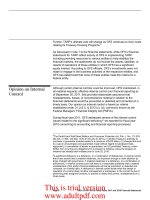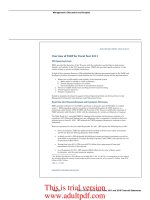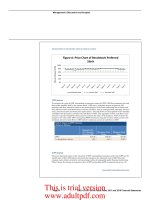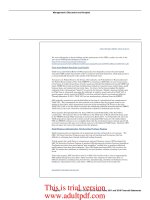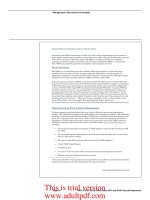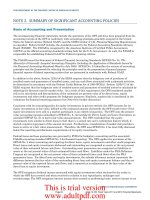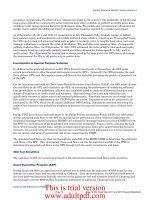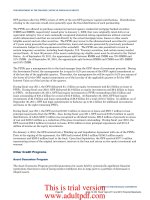United States Government Accountability Office GAO November 2011_part2 pot
Bạn đang xem bản rút gọn của tài liệu. Xem và tải ngay bản đầy đủ của tài liệu tại đây (286.35 KB, 11 trang )
Further, TARP’s ultimate cost will change as OFS continues to incur costs
relating its Treasury Housing Programs.
5
As discussed in note 1 to the financial statements, while OFS’s financial
statements for TARP reflect activity of OFS in implementing TARP,
including providing resources to various entities to help stabilize the
financial markets, the statements do not include the assets, liabilities, or
results of operations of these entities in which OFS has a significant
equity interest. According to OFS officials, OFS’s investments were not
made to engage in the business activities of the respective entities, and
OFS has determined that none of these entities meet the criteria for a
federal entity.
Although certain internal controls could be improved, OFS
maintained, in
all material respects, effective internal control over financial reporting as
of September 30, 2011, that provided reasonable assurance that
misstatements, losses, or noncompliance material in relation to the
financial statements would be prevented or detected and corrected on a
timely basis. Our opinion on internal control is based on criteria
established under 31 U.S.C. § 3512 (c), (d), commonly known as the
Federal Managers’ Financial Integrity Act (FMFIA).
Opinion on Internal
Control
During fiscal year 2011, OFS addressed several of the internal control
issues relat
ed to the significant deficiency
6
we reported for fiscal year
2010 concerning its accounting and financial reporting processes.
OFS's Fiscal Years 2011 an
d 2010 Financial Statements
5
The Dodd-Frank Wall Street Reform and Consumer Protection Act, Pub. L. No. 111-203,
title XIII, § 1302, 124 Stat. 1376, 2133 (July 21,2010), (1) limited Treasury’s authority to
purchase or guarantee troubled assets to a maximum of $475 billion; (2) changed this limit
to a cap on all purchases and guarantees made without regard to subsequent sale,
repayment, or cancellation of assets or guarantees; and (3) prohibited Treasury, under
EESA, from incurring any obligations for a program or initiative unless the program or
initiative had already been initiated prior to June 25, 2010.
6
A significant deficiency is a deficiency, or a combination of deficiencies, in internal control
that is less severe than a material weakness, yet important enough to merit attention by
those charged with governance. A material weakness is a deficiency, or a combination of
deficiencies, in internal controls such that there is a reasonable possibility that a material
misstatement of the entity’s financial statements will not be prevented, or detected and
corrected, on a timely basis. A deficiency in internal control exists when the design or
operation of a control does not allow management or employees, in the normal course of
performing their assigned functions, to prevent or detect and correct, misstatements on a
timely basis.
Page 9 GAO-12
-169
This is trial version
www.adultpdf.com
However, the remaining control issues along with additional control
deficiencies in this area that we identified in fiscal year 2011 collectively
represent a continuing significant deficiency in OFS’s internal control over
its accounting and financial reporting processes. Specifically, while OFS
improved its review and approval process for preparing its financial
statements, notes, and MD&A for TARP for fiscal year 2011, we
continued to identify incorrect amounts and inconsistent disclosures in
OFS’s draft financial statements, notes, and MD&A that were significant,
but not material, and that were not detected by OFS. For fiscal year 2011,
we also continued to identify instances where other OFS accounting and
financial reporting procedures were not complete or effectively
implemented.
OFS had other controls over TARP transactions and activities that
reduced the risk of misstatements resulting from these deficiencies. For
significant errors and issues that were identified, OFS revised the
financial statements, notes, and MD&A, as appropriate. Properly
designed and implemented controls over the accounting and financial
reporting processes are key to providing reasonable assurance regarding
the reliability of the balances and disclosures reported in the financial
statements and related notes in conformity with generally accepted
accounting principles. Misstatements may occur in other financial
information reported by OFS and not be prevented or detected by OFS
because of this significant deficiency.
The significant deficiency identified in fiscal year 2011, although not
considered to be a material weakness, is important enough to merit the
attention of those charged with governance of OFS. We will be reporting
additional details concerning this significant deficiency separately to OFS
management, along with some recommendations for corrective actions
and an assessment of the status of OFS’s actions to implement our
previous recommendations.
7
During our fiscal year 2011 audit, we also
identified another deficiency in OFS’s system of internal control that we
consider not to be a material weakness or significant deficiency, and we
will also report details on this matter along with a recommendation for
corrective action. We have communicated these deficiencies to
OFS's Fiscal Years 2011 an
d 2010 Financial Statements
7
GAO, Management Report: Improvements Are Needed in Internal Control Over Financial
Reporting for the Troubled Asset Relief Program, GAO-11-434R (Washington, D.C.: Apr.
18, 2011).
Page 10 GAO-12
-169
This is trial version
www.adultpdf.com
management and will follow up in our fiscal year 2012 audit on OFS’s
progress in implementing our recommendations.
Our tests of OFS’s compliance with selected provisions of laws and
regulations for fiscal yea
r 2011 disclosed no instances of noncompliance
that would be reportable under U.S. generally accepted government
auditing standards. The objective of our audit was not to provide an
opinion on overall compliance with laws and regulations. Accordingly, we
do not express such an opinion.
Compliance with
Laws and Regulations
OFS’s MD&A, other required supplementary information, and other
accompanying information contain a
wide range of information, some of
which is not directly related to the financial statements. We did not audit
and we do not express an opinion on this information. However, we
compared this information for consistency with the financial statements
and discussed the methods of measurement and presentation with OFS
officials. On the basis of this limited work, we found no material
inconsistencies with the financial statements, U.S. generally accepted
accounting principles, or the form and content guidance in Office of
Management and Budget Circular No. A-136, Financial Reporting
Requirements.
Consistency of Other
Information
OFS
management is responsible for
(1) preparing the financial
statements in conformity with U.S. generally accepted accou
nting
principle
s; (2) establishing and maintaining effective internal control over
financial reporting, and evaluating its effectiveness; and (3) complying
with applicable laws and regulations. OFS management evaluated the
effectiveness of OFS’s internal control over financial reporting as of
September 30, 2011, based on the criteria established under FMFIA.
OFS management’s assertion based on its evaluation is included in
appendix I.
Objectives, Scope,
and Methodology
We are responsible for planning and
performing the audit to obtain
reasonable assurance and provide our opinion about whether (1) OFS’s
financial statements are presented fairly, in all material respects, in
conformity with U.S. generally accepted accounting principles and (2)
OFS management maintained, in all material respects, effective internal
control over financial reporting as of September 30, 2011. We are also
responsible for (1) testing compliance with selected provisions of laws
and regulations that have a direct and material effect on the financial
Page 11 GAO-12
-169
OFS's Fiscal Years 2011 an
d 2010 Financial Statements
This is trial version
www.adultpdf.com
statements and (2) performing limited procedures with respect to certain
other information accompanying the financial statements.
In order to fulfill these responsibilities, we
examined, on a test basis, evidence supporting the amounts and
disclosures in the financial statements;
assessed the accounting principles used and significant estimates
made by management;
evaluated the overall presentation of the financial statements;
obtained an understanding of the entity and its operations, including
its internal control over financial reporting;
considered OFS’s process for evaluating and reporting on internal
control over financial reporting that OFS is required to perform by
FMFIA and Section 116(c) of EESA;
assessed the risk that a material misstatement exists in the financial
statements and the risk that a material weakness exists in internal
control over financial reporting;
evaluated the design and operating effectiveness of internal control
over financial reporting based on the assessed risk;
tested relevant internal control over financial reporting;
tested compliance with selected provisions of the following laws and
regulations: EESA, as amended; the Antideficiency Act; the Federal
Credit Reform Act of 1990; the Dodd-Frank Wall Street Reform and
Consumer Protection Act; and the Purpose Statute; and
performed such other procedures as we considered necessary in the
circumstances.
An entity’s internal control over financial reporting is a process effected by
those charged with governance, management, and other personnel, the
objectives of which are to provide reasonable assurance that (1)
transactions are properly recorded, processed, and summarized to permit
the preparation of financial statements in conformity with U.S. generally
accepted accounting principles, and assets are safeguarded against loss
from unauthorized acquisition, use, or disposition; and (2) transactions
are executed in accordance with the laws governing the use of budget
authority and other laws and regulations that could have a direct and
material effect on the financial statements.
We did not evaluate all internal controls relevant to operating objectives
as broadly established under FMFIA, such as those controls relevant to
preparing statistical reports and ensuring efficient operations. We limited
our internal control testing to testing controls over financial reporting. Our
Page 12 GAO-12
-169
OFS's Fiscal Years 2011 an
d 2010 Financial Statements
This is trial version
www.adultpdf.com
Page 13 GAO-12-169 OFS's Fiscal Years 2011 and 2010 Financial Statements
internal control testing was for the purpose of expressing an opinion on
the effectiveness of internal control over financial reporting and may not
be sufficient for other purposes. Consequently, our audit may not identify
all deficiencies in internal control over financial reporting that are less
severe than a material weakness. Because of inherent limitations, internal
control may not prevent or detect and correct misstatements due to error
or fraud, losses, or noncompliance. We also caution that projecting any
evaluation of effectiveness to future periods is subject to the risk that
controls may become inadequate because of changes in conditions, or
that the degree of compliance with the policies or procedures may
deteriorate.
We did not test compliance with all laws and regulations applicable to
OFS. We limited our tests of compliance to selected provisions of laws
and regulations that have a direct and material effect on the financial
statements for fiscal year 2011. We caution that noncompliance may
occur and not be detected by these tests and that such testing may not
be sufficient for other purposes.
We performed our audit in accordance with U.S. generally accepted
government auditing standards. We believe our audit provides a
reasonable basis for our opinions and other conclusions.
In commenting on a draft of this report, the Assistant Secretary, Office of
Financial Stability, stated that OFS concurred with GAO’s audit finding
concerning a significant deficiency in its internal control over financial
reporting that GAO identified. He also stated that OFS is committed to
correcting the deficiency. The complete text of OFS’s comments is
reprinted in its entirety in appendix II.
Gary T. Engel
Director
Financial Management and Assurance
November 4, 2011
Agency Comments
This is trial version
www.adultpdf.com
Management’s Discussion and Analysis
Page 14 GAO-12-169
Management’s Discussion and Analysis
AGENCY FINANCIAL REPORT | FISCAL YEAR 2011
EXECUTIVE SUMMARY
EXECUTIVE SUMMARY
Treasury’s Office of Financial Stability (OFS) presents to the reader the Fiscal Year 2011 Agency
Financial Report for the Troubled Asset Relief Program (TARP), established by the Department of
the Treasury pursuant to the Emergency Economic Stabilization Act of 2008 (EESA). Three years
after the establishment of the TARP, substantial progress continues to be made in stabilizing the
financial system and OFS is unwinding the extraordinary assistance that was provided during the
crisis.
Three years ago, the U.S. financial system was at risk of collapse and many major financial
institutions were at risk of failure. Markets had ceased to function. Without immediate and forceful
government action, our country faced the possibility of a second Great Depression, which would have
had profound consequences for all Americans.
In this environment of fear and panic, TARP was created as a central part of a series of emergency
measures. The goal of TARP, along with other federal government actions, was to stop the panic and
restore stability to the U.S. financial system. TARP’s initiatives were done faster, and at a much
lower cost, than many anticipated.
As of October 3, 2010, OFS’ authority to make new commitments under TARP expired. TARP, in
conjunction with other federal government actions, helped to unfreeze the markets for credit and
capital, bringing down the cost of borrowing for businesses, individuals, and state and local
governments, restoring confidence in the financial system and restarting economic growth.
During fiscal year 2011, OFS focused principally on (i) exiting remaining investments in a timely
and orderly manner consistent with the duty to promote financial stability and protect taxpayers’
interests that maximizes the return for taxpayers, and (ii) continuing to help homeowners avoid
preventable foreclosures.
In fiscal year 2011, OFS’ progress included the following:
x The series of programs that OFS launched to help stabilize the nation’s banking institutions
are now producing a profit to taxpayers. A total of $245 billion was invested in banking
institutions pursuant to several TARP initiatives. Since its inception and through
September 30, 2011, OFS has collected approximately $258 billion through repayments,
sales, dividends, interest, and other income approximately $13 billion more than
disbursements under these initiatives including collections for the Asset Guarantee
Program for which nothing was disbursed by OFS.
x OFS reduced its stake in General Motors Company by 50 percent through General Motors’
highly successful Initial Public Offering with OFS receiving $13.5 billion from the sale of a
portion of its General Motors common stock holdings. OFS has exited its investment in
Chrysler Group, as Chrysler Group repaid its loans six years earlier than the loan’s maturity
date. To date, OFS has collected more than $40 billion (including repayments, sales,
dividends, interest and other income) of the $80 billion invested in companies related to the
auto industry.
x OFS, working with other federal entities, closed a major restructuring plan for American
International Group, Inc. (AIG), marking a significant milestone in the company’s
turnaround and putting OFS in a better position to recover its investment in AIG. In May
2011, Treasury completed the sale of 200 million shares (132.0 million shares were OFS’
shares) of AIG common stock, reducing Treasury's percentage ownership of AIG’s
outstanding shares from approximately 92 percent to 77 percent; and leaving OFS owning
960 million shares or approximately 50.8 percent of AIG’s common stock equity on a fully
diluted basis.
OFS's Fiscal Years 2011 and 2010
Financial Statements
This is trial version
www.adultpdf.com
Management’s Discussion and Analysis
THE DEPARTMENT OF THE TREASURY | OFFICE OF FINANCIAL STABILITY
EXECUTIVE SUMMARY
As a result of improved financial conditions of TARP participants, earlier than expected asset
repayments, lower utilization of the program and careful stewardship, the estimated cost of TARP is
significantly below original projections. In the August 2009 Midsession Review of the President’s
2010 Budget, the lifetime cost of TARP, based on budget scoring conventions, was projected to be
$341 billion (assuming the full $700 billion of TARP authority was utilized). In the 2011 President’s
Budget (released in February 2010), the lifetime cost of TARP had decreased to $116.8 billion
(assuming $546 billion of the $700 billion TARP authority was utilized). In the 2012 President’s
Budget (released in February 2011), the lifetime cost of TARP had decreased to $48.5 billion
(assuming $474.8 billion of the TARP authority was utilized). The most recent estimates as of
September 30, 2011, reflect a lifetime cost included in the budget of $70.2 billion, based on utilizing
$470 billion of the TARP authority.
1
The estimated lifetime cost of TARP reflects several factors, including the cost of the initiatives to
help homeowners stay in their homes, for which $45.6 billion has been committed, of which $2.4
billion has been disbursed. OFS’ housing program disbursements were never intended to be
recovered and OFS does not expect them to result in any repayments. The estimated lifetime cost
also reflects costs related to investments in the auto companies and AIG. These costs fluctuate in
large part due to market prices of common stock, and declines in market prices largely account for
the increase in the estimated lifetime cost of TARP from the estimates in the 2012 President’s
Budget. These costs are offset in part by income on TARP investments in banks and other programs.
Note that the lifetime cost of TARP, based on budget scoring conventions, differs from the cost
included in the OFS financial statements. Estimates of lifetime costs assume that all planned
expenditures are made. By contrast, the TARP financial statement costs are based on transactions
through September 30, 2011.
The reported cost of TARP activities from inception, on October 3, 2008, through September 30,
2011, based on the OFS financial statements, was $28.0 billion. Unlike the federal budget cost
estimate, this reflects only transactions through September 30, 2011. Thus, it does not include the
committed but undisbursed funds for housing programs as well as other programs all of which are
included in the expected lifetime cost for budget purposes. The $28.0 billion cost consists of $9.5
billion of reported TARP net cost in the OFS financial statements for fiscal year 2011; $23.1 billion of
reported TARP net income for fiscal year 2010 and the $41.6 billion of reported TARP net cost for the
period from inception through September 30, 2009. The change of $9.5 billion since fiscal year 2010
is primarily due to declines in the value of OFS’s investments in GM, Ally Financial, and AIG, and
continued funding of the Treasury Housing Programs Under TARP.
Since its inception, TARP has disbursed $413.4 billion in direct loans, equity investments and for the
Treasury Housing Programs Under TARP, collected $276.9 billion from repayments and sales, and
reported $20.4 billion in dividends, interest and fees, $9.1 billion in warrant sales, and $9.7 billion in
net proceeds from the sale and repurchase of assets in excess of costs. As of September 30, 2011,
TARP had $122.4 billion in gross outstanding direct loans and equity investments, which are valued
at $80.1 billion. In addition, from inception through September 30, 2011, TARP incurred costs
related to Treasury housing programs of $2.8 billion and administrative costs of $0.8 billion.
OFS continues to provide detailed information about TARP to ensure the highest level of
transparency. OFS published a Two-Year Retrospective Report on the Troubled Asset Relief
Program on October 5, 2010, and a corresponding Three-Year Anniversary Report on October 3,
2011. These reports include detailed information on TARP as well as the federal government’s
1
The Dodd-Frank Wall Street Reform and Consumer Protection Act (P.L. 111-203) amended EESA Section 115
authority to cap total purchase and guarantee authority at a cumulative $475 billion.
Page 15 GAO-12-169
OFS's Fiscal Years 2011 and 2010
Financial Statements
This is trial version
www.adultpdf.com
Management’s Discussion and Analysis
AGENCY FINANCIAL REPORT | FISCAL YEAR 2011
EXECUTIVE SUMMARY
additional emergency measures to address the 2008 financial crisis. OFS also publishes a monthly
report on the program, a monthly report on its housing initiatives and a variety of other reports.
Please refer to these documents at: />room/reports/agency_reports/Pages/default.aspx.
Page 16 GAO-12-169
OFS's Fiscal Years 2011 and 2010
Financial Statements
This is trial version
www.adultpdf.com
Management’s Discussion and Analysis
THE DEPARTMENT OF THE TREASURY | OFFICE OF FINANCIAL STABILITY
MANAGEMENT‘S DISCUSSION AND ANALYSIS
MANAGEMENT’S DISCUSSION AND ANALYSIS
Background, Mission, and OFS Organization Structure
In order to appreciate the effects of the TARP and the concentrated efforts of the Administration to
combat the financial crisis, it is useful to examine the origin and causes of the crisis.
In September 2008, the nation was in the midst of one of the worst financial crises in our history.
The financial institutions and markets that Americans rely upon to protect their savings, help
finance their children’s education, and help pay their bills, and that businesses rely upon to make
payroll, build inventories, fund new investment, and create new jobs, were threatened, unlike at any
time since the Great Depression. Across the country, people were rapidly losing confidence in our
financial system and in the federal government’s ability to safeguard their economic future.
The causes of the crisis will be studied for years, and this report is not meant to provide a
comprehensive analysis of why the crisis occurred. But some reasons are clear. Over the two
decades preceding the crisis, the financial system had grown rapidly in an environment of economic
growth and stability. Risks grew in the system without adequate transparency. Lax regulations and
loopholes in supervision let firms become highly leveraged and take on too much risk. Ample credit
around the world fueled an unsustainable housing boom in the first half of the last decade. When
the housing market inevitably turned down, starting in 2006, the pace of mortgage defaults
accelerated at an unprecedented rate. By mid 2007, rising mortgage defaults were undermining the
performance of many investments held by major financial institutions.
The crisis began in the summer of 2007 and gradually increased in intensity and momentum over
the course of the following year. A series of major financial institutions, including Countrywide
Financial, Bear Stearns, and IndyMac, were purchased under duress or failed; and Fannie Mae and
Freddie Mac, the largest purchasers and guarantors of home loans in the mortgage market, came
under severe stress.
By September 2008, for the first time in 80 years, the U.S. financial system was at risk of collapse.
Using authority granted in July 2008, the Federal Housing Finance Agency placed Fannie Mae and
Freddie Mac into conservatorship on September 7, 2008. A growing sense of panic was producing the
classic signs of a generalized run on the banks. People’s trust and confidence in the stability of
major institutions, and the capacity of the federal government to contain the damage, were
vanishing.
The U.S. system of regulation and supervision had failed to constrain the excessive use of leverage
and the level of risk in the financial system and the United States entered this crisis without
adequate tools to manage it. The Executive Branch did not have existing options for managing
failures of systemically important non-bank financial institutions.
The Department of the Treasury, the Federal Reserve Board, the Federal Deposit Insurance
Corporation (FDIC), and other federal government bodies undertook an array of emergency actions
to prevent a collapse and the dangers posed to consumers, businesses, and the broader economy.
However, the severe conditions our nation faced required additional resources and authorities.
Therefore, the Bush Administration proposed the Emergency Economic Stabilization Act (EESA) to
create the TARP in late September, and with the support of Democrats and Republicans in Congress,
it was enacted into law on October 3, 2008.
Page 17 GAO-12-169
OFS's Fiscal Years 2011 and 2010
Financial Statements
This is trial version
www.adultpdf.com
Management’s Discussion and Analysis
AGENCY FINANCIAL REPORT | FISCAL YEAR 2011
MANAGEMENT‘S DISCUSSION AND ANALYSIS
EESA established the Office of Financial Stability (OFS) within the Office of Domestic Finance of the
Department of the Treasury (Treasury) to implement the TARP. The mission of OFS is to carry out
the authorities given to the Secretary of the Treasury to implement the TARP. Section 101 of EESA
authorized the Secretary of the Treasury to establish the TARP to “purchase, and to make and fund
commitments to purchase, troubled assets from any financial institution, on terms and conditions as
are determined by the Secretary”. EESA defines the terms “troubled assets” and “financial
institution” and provides other requirements that must be met for any such purchase. Section 102 of
EESA also provides authority for a guarantee program for troubled assets. Section 109 of EESA
provides authority to maximize assistance for homeowners. The enactment of the Dodd-Frank Wall
Street Reform and Consumer Protection Act (the Dodd-Frank Act) in July 2010 reduced total TARP
purchase authority from $700 billion to a cumulative $475 billion.
Final purchase authority to make new commitments under TARP expired on October 3, 2010. This
means no new commitments can be made. There is, however, still significant work to be done to
implement commitments made prior to the October 3 deadline but not yet fully funded. For those
assets already purchased, OFS will continue to wind down TARP and manage the remaining TARP
investments in order to recover as much of taxpayers’ funds as possible.
OFS is headed by the Assistant Secretary for Financial Stability, appointed by the President with
the advice and consent of the Senate. Reporting to the Assistant Secretary for Financial Stability
are six major organizations: the Chief Investment Officer, the Chief Financial Officer, the Chief of
Operations, the Chief of Homeownership Preservation, the Chief of OFS Internal Review and the
Chief Reporting Officer. A Chief Counsel’s Office reports to the Assistant Secretary and to the Office
of the General Counsel in the Department of Treasury.
The OFS organization chart is shown below:
The Office of the Chief Investment Officer (CIO) is responsible for program development and the
execution and management of all investments made by either purchasing or insuring “troubled
assets” pursuant to EESA, other than TARP housing programs.
Assistant
Secretary for
Financial
Stability
Chief
Investment
Officer
Chief of OFS
Internal
Review
Chief
Reporting
Officer
Chief of Home
Ownership
Preservation
Chief of
Operations
Chief Financial
Officer
Chief
Counsel
Page 18 GAO-12-169
OFS's Fiscal Years 2011 and 2010
Financial Statements
This is trial version
www.adultpdf.com
Management’s Discussion and Analysis
THE DEPARTMENT OF THE TREASURY | OFFICE OF FINANCIAL STABILITY
MANAGEMENT‘S DISCUSSION AND ANALYSIS
The Office of the Chief Financial Officer (CFO) has lead responsibility within OFS for budget
formulation and execution, cash management, accounting, financial systems, financial reporting,
program and internal metrics analytics, modeling cash flows, and internal controls.
The Office of the Chief of Operations is responsible for developing the operating infrastructure and
managing internal operations in OFS.
The Office of the Chief of Homeownership Preservation is responsible for identifying opportunities to
help homeowners and overseeing homeownership programs while also protecting taxpayers.
The Office of Internal Review (OIR) is responsible for identifying the most significant risks that the
TARP faces, both internally and externally. In addition, OIR is responsible for verifying that
internal controls are present and functioning correctly and for monitoring TARP recipient and
external entity compliance with various statutory and regulatory requirements.
The Office of the Chief Reporting Officer is responsible for periodic reports to the Congress as
required by EESA.
The Office of the Chief Counsel reports functionally to the Office of General Counsel at the
Department of the Treasury and provides legal advice to the Assistant Secretary. The Office is
involved in the structuring of OFS programs and activities to ensure compliance with EESA and
with other laws and regulations. The Office of the Chief Counsel is also responsible for coordinating
OFS’ work with the external oversight entities including the Government Accountability Office
(GAO), the Special Inspector General for TARP (SIGTARP), the Financial Stability Oversight Board
and the Congressional Oversight Panel (COP) through the end of its existence on April 3, 2011.
OFS is not envisioned as a permanent organization, so to the maximum extent possible when
economically efficient and appropriate, OFS utilizes private sector expertise in support of the
execution of TARP programs. Fannie Mae and Freddie Mac accounted for more than half of the
fiscal year 2011 administrative cost ($173 million of $315 million) to assist in the administration and
compliance oversight, respectively, of the Making Home Affordable Program. Additionally, asset
managers were hired to serve as financial agents in assisting with managing the assets associated
with several TARP programs. Private sector firms were also engaged to assist with the significant
volume of work associated with the TARP in the areas of custodial services, accounting and internal
controls, modeling, administrative support, facilities, legal advisory, financial advisory, and
information technology.
Page 19 GAO-12-169
OFS's Fiscal Years 2011 and 2010
Financial Statements
This is trial version
www.adultpdf.com

